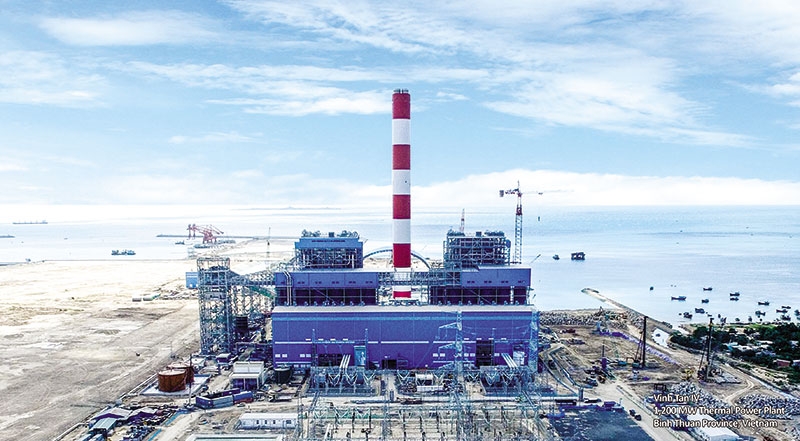Power players eye renewable energy
 |
| Current power investors in Vietnam like CSG are resetting focus on renewable energy, photo Phuong Thu |
Malaysia’s Jaks Resources Bhd. and China Power Engineering Consulting Group Co., Ltd., that are building a 1,200 megawatt (MW), $1.87-billion coal-fired power plant in the northern province of Hai Duong, are seeking more power projects in other provinces in Vietnam, with a focus on the renewable energy segment.
Renewable energy is still in its infancy in Vietnam, due to its high costs and weather conditions in certain areas that are not conducive to wind and solar power generation.
“Aligning with our strategy, we will grow our power portfolio in Vietnam with a view to participating in the recent renewable energy drive in the country,” said Elaine Tai, general manager of Corporate Strategy at Jaks Resources.
In a recent visit to the southern province of Binh Phuoc, Haris F. Abdullah, representative of Jaks Resources in Vietnam, said that the firm plans to invest in a solar power project with the capacity of 200MW and total investment capital of $262.5 million, on an area of 240 hectares. The project would be divided into two phases, with the first phase boasting a capacity of 50MW and investment of $87.5 million, and covering 80ha.
Jaks Resources said it could develop upcoming projects in Vietnam alone or by forming a joint venture, depending on the size of the investment.
In the next two years, Jaks Resources sees the thermal power plant in Hai Duong driving the group’s profit growth, according to a report on its website.
“The construction of the power plant is currently 22 per cent complete and is scheduled to reach 50 per cent by the end of the year. There is a strong indication that work on the project will be expedited for full completion in 2020. As such, 2018 and 2019 are crucial years for us,” Jaks Resources CEO Ang Lam Poah confirmed.
The Hai Duong power plant, which was licensed in 2011, will be the Malaysian company’s first foray into the Vietnamese power generation industry. It started construction in March 2016. The project is being conducted through a build-operate-transfer contract, and will be handed over to the Vietnamese government after the 25-year term ends.
In a related development, a representative of China Southern Power Grid Company (CSG), the investor of the $1.75-billion Vinh Tan 1 thermal power project, which is the largest Chinese-invested project in Vietnam, told VIR, “With a desire to continue to contribute to the development of Vietnam’s electric and electronics industry, CSG is continuing to co-operate with state-run Electricity of Vietnam EVN to develop and distribute power transmission and distribution systems. In addition, CSG is seeking opportunities to invest in renewable energy projects such as wind and solar power, waste-to-electricity, and more.”
CSG has been co-operating with EVN and the Vietnamese government on developing the power sector in the country since the late 1990s.
CSG has not only successfully developed the Vinh Tan 1 thermal power project under the build-operate-transfer format, it also implemented several 220 and 500kV transmission lines to supply electricity to northern Vietnam.
Phan Ngoc Cam Thanh, deputy director of Vinh Tan 1 Plant, revealed that the first unit of the plant will come into commercial operation in July, five months earlier than initially scheduled.
On April 18, this first unit was successfully connected to the national grid for initial testing and met all standard requirements.
It is slated to help increase the energy supply to the country’s southern regions, as there are concerns over power supply risks due to delays in the Song Hau 1 and Long Phu 1 thermal power projects.
In a previous interview with VIR, Paddy Padmanathan, CEO and president of ACWA Power International, the investor of the Nam Dinh 1 thermal power project in the northern province of Nam Dinh, said, “We are keen to invest in more power plants, using local ‘fuel’ resources, which includes solar and wind resources. So, our next projects will likely focus on development in the area of renewable energy.”
“We have already entered into a partnership with FECON, a well-established and respected Vietnamese engineering contractor, to develop a 100MW photovoltaic power plant as our next investment,” he added.
Vietnam’s electricity demand is expected to see an increase of more than 10-15 per cent per year over the next few years, due to the rising population and accelerating economic growth.
Southern Vietnam, the country’s largest economic bloc which includes Ho Chi Minh City, faces a critical situation in relation to the current imbalance between the existing supply and the increasing demand for electricity.
What the stars mean:
★ Poor ★ ★ Promising ★★★ Good ★★★★ Very good ★★★★★ Exceptional
 Tag:
Tag:
Related Contents
Latest News
More News
- Global partnerships key to Vietnam’s IFC development (December 26, 2025 | 16:18)
- Vingroup pulls out of bid to invest in North-South high-speed railway (December 26, 2025 | 11:42)
- Strengthening supply chains through trade promotions and customs reform (December 24, 2025 | 14:00)
- PM orders investment model for North–South high-speed rail (December 22, 2025 | 17:43)
- LS Eco Energy to invest in Vietnam rare earth sector (December 22, 2025 | 17:31)
- Government moves to establish International Financial Centre (December 21, 2025 | 21:00)
- Vietnam's IFC to target global investment flows (December 21, 2025 | 18:00)
- Two national hospitals expand capacity with new facilities (December 20, 2025 | 09:00)
- Ha Tinh breaks ground on major Vingroup industrial and energy projects (December 19, 2025 | 18:24)
- EVN launches major power infrastructure projects nationwide (December 19, 2025 | 18:17)























 Mobile Version
Mobile Version